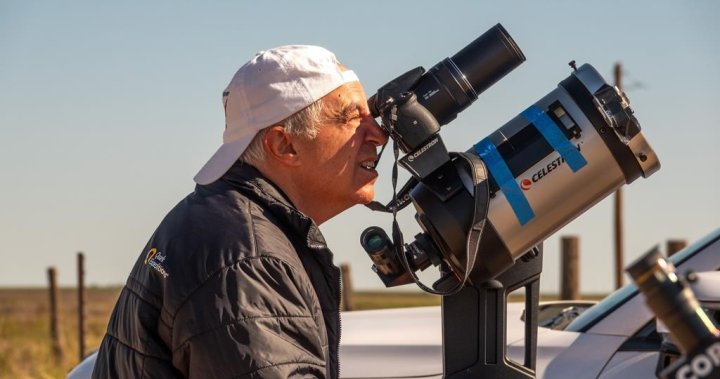Evan Zucker has been on a cross-continent journey from San Diego, chasing clear skies ahead of Monday’s total solar eclipse.
While he originally planned on watching in Texas, a cloudy forecast had him and his wife, Paula, packing up their Kia SUV with their cameras and telescopes and starting the long drive to Sherbrooke, Que., 130 kilometres east of Montreal.
Eclipse chasing, he said, is “all about the weather.”
In order to maximize his chances, the 68-year-old made cancellable reservations a year ago in half a dozen cities that fall along the eclipse’s path, including Dallas; Little Rock, Ark.; and Rochester, N.Y.
While he may still change his mind, he expects Quebec’s Eastern Townships to be his final destination, and he believes other eclipse-watchers will follow. As the forecast in the southwestern United States has darkened, he said the best weather is increasingly looking like it will be in the northeast, including parts of Quebec and New Brunswick.
Lysandre Michaud-Verreault, a spokeswoman for the regional tourism office, said the Eastern Townships are ready for an influx, with more than 40 viewing parties and events planned. She said the region is special because it offers stargazing potential that goes beyond the eclipse.
“It’s exceedingly rare for such a unique astronomical phenomenon to take place here, where the heart of the eclipse is positioned above two dark sky preserves and above the ASTROlab,” Michaud-Verreault said, referring to an observatory and astronomy museum near Lac-Megantic, Que. “It’s really something for the Eastern Townships.”
As they make their way toward Quebec, Zucker and his wife have been dealing with “really bad weather” on the road, including tornadoes, severe thunderstorms and flooding. “It’s been a real challenge,” he said. But it will be worth it if he can reach clear skies to watch his 10th total eclipse.
Zucker said he’s been fascinated by the celestial phenomenon since he was a teenager in New York, when at 14 years old he convinced some of his teachers to drive him to Virginia for his first total eclipse on March 7, 1970.
“It’s just very visceral,” said Zucker, who spoke to The Canadian Press as he travelled north from Ohio. “The sun basically disappears, replaced by a big black disc of the moon and the white curly atmosphere of the corona around it.
Breaking news from Canada and around the world
sent to your email, as it happens.
“It’s like nothing else you can see on Earth.”
Canadian cities from Niagara Falls, Ont., to Gander, N.L., are preparing to welcome visitors hoping to spend a few minutes plunged into darkness during the rare alignment of the sun, Earth and moon.
Ontario, Quebec, New Brunswick, Nova Scotia, Prince Edward Island and Newfoundland and Labrador all have areas along the path of totality — where the moon will be seen fully blocking out the sun. Airbnb reports that Niagara Region and Montreal are the two most booked Canadian destinations ahead of April 8.
The flagship event in the Eastern Townships will take place in and around the ASTROlab, where scientists and presenters will guide activities, and an outdoor stage will be set up to broadcast the eclipse’s progress on a giant screen.
Many towns will host their own smaller events, with amateur astronomers on hand to give explanations, as well as food, crafts and free eclipse glasses to protect eyesight.
A history museum in Magog, Que., is offering an old-fashioned eclipse day, complete with actors in period costumes and the chance to build a pinhole eclipse box and safely observe the celestial phenomenon through it. Hampden, Que., is having a viewing event featuring free eclipse-themed food, including “solar” juice, “meteorite” cotton candy and “total eclipse” pizza.
The region has several ski hills, and most of them are hosting guided hikes or chairlift rides for viewing parties on the summit, Michaud-Verreault said.
Outside of the Eastern Townships, Montreal is expected to host several large viewing events, including one at Parc Jean-Drapeau, on an island in the St. Lawrence River, that will be attended by Canadian Space Agency astronaut David Saint-Jacques.
Zucker says he likely won’t be at a major event. While he likes to watch with others and will bring hundreds of eclipse glasses to hand out, he travels with 11 still and video cameras and three telescopes, which require a lot of room.
He says he’s hoping to find a spot with a good view of not only the eclipse itself but also the different horizons, so he can photograph the moon’s shadow coming in from the southwest and departing to the northeast.
While he had originally dubbed this month’s event the “great American eclipse,” his northern trip has him calling it the “Great North American eclipse” instead. A solar eclipse in 2017 was only in the U.S., he said. “This one is in Mexico, the U.S. and Canada.”


